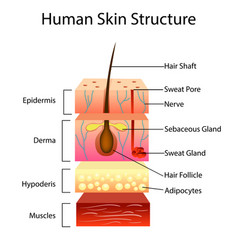The skin is the body’s largest organ comprising approximately 15% of our total body weight.
The skin is has three major components, these include the epidermis (superficial) layer, the dermis (deep) layer and subcutaneous fat. Skin conditions may effect one or all of these three layers.
The epidermis consists of protein cells known as keratinocytes which are waterproof and protect the skin and underlying tissue. It does not have its own blood supply, so receives nutrients from the underlying dermal layer.
The dermis is responsible for supporting the epidermis and providing strength and elasticity to the skin, with collagen and elastin fibers. Hair roots, sebaceous (oil), sweat glands, blood vessels and nerves all originate in this layer.
The subcutaneous fat, which lays under the dermis is responsible for insulation and shock absorption.
The skin on the feet, is unique as it is 20x thicker than the skin on the rest of our body. This is because it must undergo a lot more tensile stretch and sheer pressure from standing and walking.
Podiatrists assess, diagnose and treat both common and rare skin conditions, which may also impact on the toenails and joints of the feet and lower limb.
The Skin’s Role:
Protection
- From chemical, mechanical and thermal trauma.
Metabolism
- Involved in the production of Vit D and the regulation of calcium absorption.
- Allows the removal of waste with sweating.
Thermal Regulation
- Via the release and evaporation of sweat.
- Keeps us warm via hair and subcutaneous fat.
- Vasodilation (expanding) of the blood vessels to the skins surface to cool the body.
- Vasoconstriction (reduction) of the blood vessels to the skins surface to keep the vital organs warm if required.
Immunity
- Slightly acidic pH to kill pathogens.
- Certain cells on the skins surface fight pathogens as our first line of protection.
Common Skin Conditions Include:
- Cutaneous Lichen Planus
- Eczema
- Psoriasis
- Tinea


